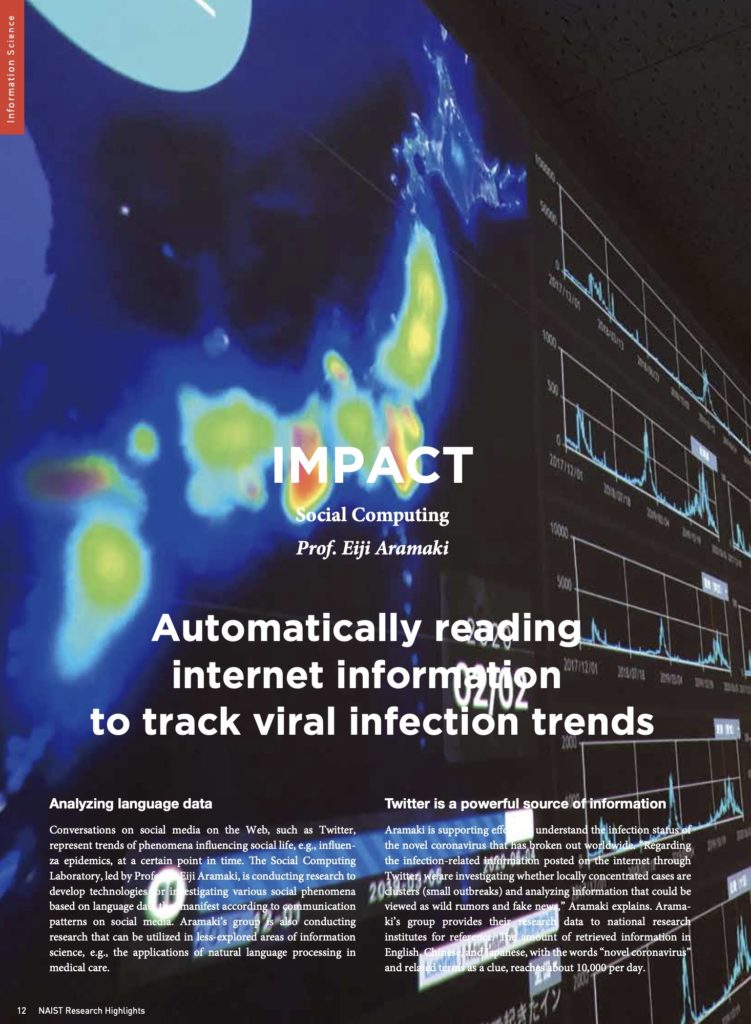Social Media Mining to Prevent Epidemic Outbreaks
Seasonal influenza and other infectious diseases affect more than a million people in Japan every year, posing a significant challenge to national health. To grasp the current status of epidemic outbreaks, and to predict future episodes, our laboratory analyzes posts made on Twitter, one of the most widely used social media platforms in Japan. Our work captured wide attention as an effective approach to utilizing tweets for practical applications, and has been quoted in a large number of peer-reviewed academic articles (270 as of 2016). “Kazemiru,” the website one pharmaceutical company developed to take advantage of our technology, was a Gold Winner in the CLIO Healthcare Awards, an esteemed international competition for creative businesses.
Efforts to improve the practical usability of our data mining technology in the form of a new alert system called NAIST-ARS (All-Range Surveillance) are ongoing under the Grant Program “Fast and Comprehensive Genomic Analysis of Pathogens and Establishment of Capacities for Epidemic Preparedness and Response,” sponsored by the Japan Agency for Medical Research and Development (AMED).
Speech-Based Detection of Dementia Symptoms
Healthcare for the elderly is a national concern in Japan, the world’s fastest aging country. It is estimated that patients with dementia and mild cognitive impairment in Japan account for one-fourth of the national population and annually require \10 trillion worth of medical costs (MHLW, 2010). Establishing effective treatment approaches for dementia is critical, and the importance of early detection and interventions for delaying disease progression can never be overestimated. Such interventions will help expand the duration that patients can live independently.
We are engaged in developing an easy and user-friendly testing system that can identify patients who have or are anticipated to develop dementia based on their writing and speech capabilities. For this purpose, we have developed an interactive testing system termed the “Intelligent Tea Ceremony Room.” This system enables audio and visual recording of the study subject, while projecting visual images in front of and on both sides of the subject.
Extracting Information from Medical Documentation
As part of the 2001 initiative “Grand Design for IT Development in Insured Medical Services,” the National Government encouraged wider use of the electronic health record system. As a result, health IT has expanded at a rapid pace, accumulating an unprecedented amount of electronic medical and clinical data. Since medical charts contain confidential medical information, medical data must be de-identified and standardized before they can be shared and analyzed by third parties.
Our laboratory has been involved in studies on large-scale health record analysis. Our technologies have been utilized for patient data retrieval at the Japanese Society of Internal Medicine (JSIM), the Japanese Circulation Society, and other medical organizations.
- The JSIM Case Reporting and Retrieval System (accessible to members only).
NLP for Japanese-Language Medical Charts: A competition workshop
Increasing adoption of the electronic medical record system in recent years has underscored the significance of NLP in healthcare. To facilitate efficient and organized development of NLP technologies, North American and European researchers have cooperated to establish standard formats. Competition workshops are often held, in which data in the standard formats are used for processing tasks. Such standardized data were available only in the English language for a long period of time, and the development of an open database of Japanese healthcare records was expected to encourage the involvement of researchers who are interested in developing health NLP technologies but do not have relevant data to work on, as well as companies that possess NLP technologies applicable to healthcare data. Under these circumstances, we created an annotated database of hypothetical Japanese healthcare records that can be used for research purposes. It is available to the research community together with possible analytical tasks that will assist the user in learning how to process the data. The Japanese medical record database that our laboratory offers is currently the only non-English database available for research purposes. We hosted workshops using this data set; 12 domestic groups (27 systems) participated in the 2011 workshop, and 12groups (45 systems) participated in the 2013 workshop, including 7 overseas and 7 private-sector groups.
